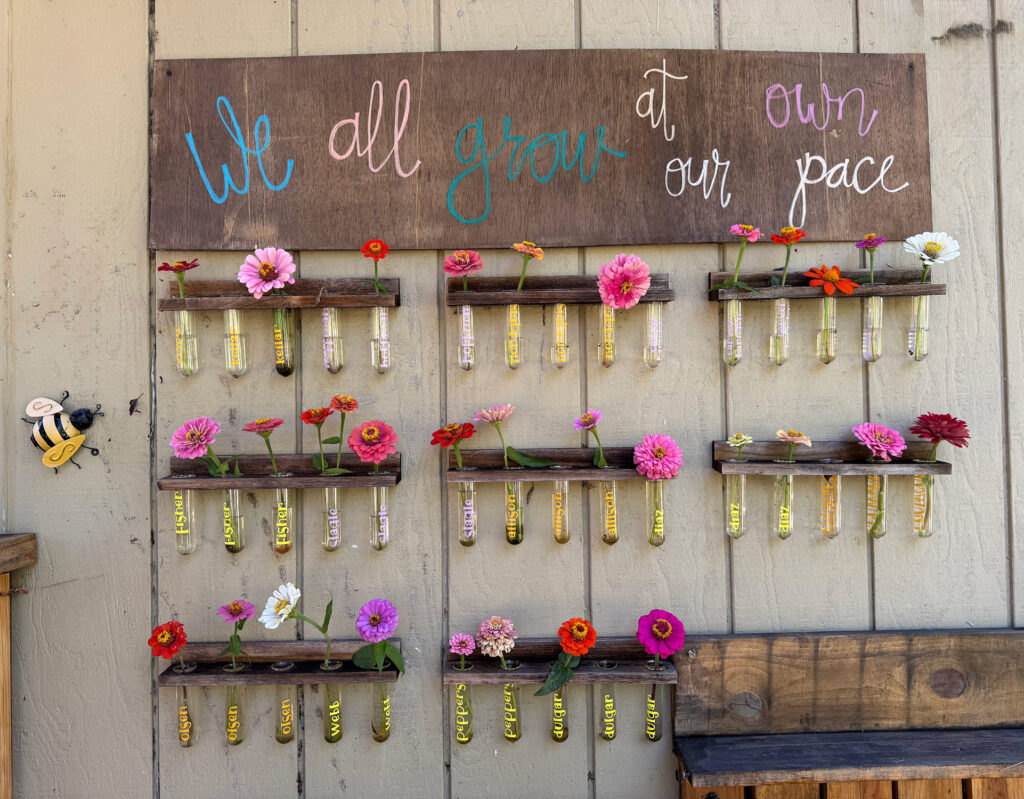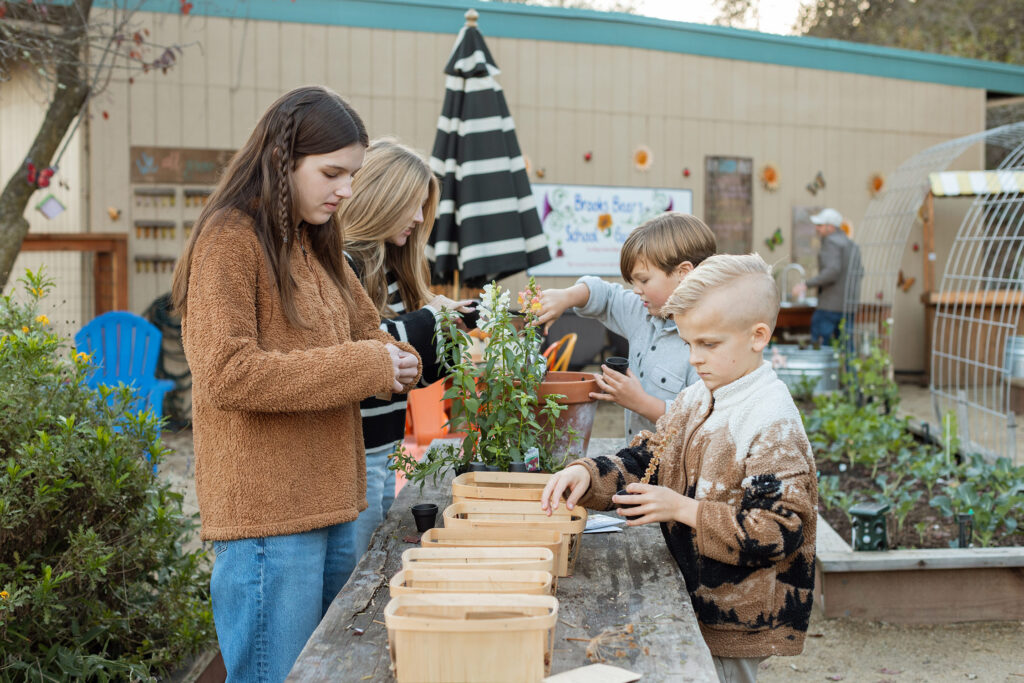A school garden is more than a patch of dirt—it’s a classroom without walls, a lab for curious minds, and a playground for growing confidence. In the Central Coast of California, two moms, Christy Calderon and Shelley Joyer of Between Two Shrubs, have turned this vision into a reality for their children and their school community. Their garden is lush, productive, and inspiring—a place where seeds of knowledge and friendship bloom side by side. Whether you’re planting your first seeds or giving an existing garden a fresh new life, Christy and Shelley share their expertise and guidance on creating a school garden that grows both plants and community.
D. Lillian Photography
Why School Gardens Matter
School gardens bring learning to life. Students explore science by testing soil, practice math by measuring plant beds, and discover art through garden journals or seasonal murals. Christy and Shelley were inspired by Alice Waters and her Edible Schoolyard in Berkeley, California. “Her vision of an outdoor learning environment motivated us to create a similar program for our own children and the students at our school,” they say. Beyond academics, gardens nurture social-emotional growth, teaching patience, teamwork, and environmental stewardship. And when parents, teachers, and neighbors get involved, the garden becomes a hub for community connection.

Getting Started
For schools starting from scratch, the first step is simple: just begin. “You don’t have to be a gardener, and it’s fine if you’ve never kept a houseplant alive. You’ll figure it out as you go,” Christy and Shelley advise. “Our biggest tip is to find someone to do it with. Even as a volunteer—it’s a big job, and having someone to do it with makes it easier and way more enjoyable. We met in the school garden—so as cheesy as it sounds, it’s not just about growing plants, it’s about growing friendships too.”
Enthusiasm from teachers, administrators, and parents follows when the garden is clearly tied to learning. Aligning garden activities with classroom goals, hosting interactive demos, and sharing updates creates buy-in. “When people see that the garden isn’t just extra—it’s enriching—they’re much more likely to support it,” Christy and Shelley note.
Beginner-friendly plants help kids feel the magic quickly. Radishes, carrots, snap peas, and tomatoes give near-instant gratification and snackable rewards, making learning about growth and nutrition a hands-on delight. Local nurseries can also be invaluable resources for advice on what to plant and when.

D. Lillian Photography
Expanding Beyond Raised Beds
Once the basics are in place, school gardens can grow vertically, literally and figuratively. Christy and Shelley added an orchard with 17 fruit trees—citrus, apple, pear, and peach—all suited to their Zone 9b West Coast climate. They also incorporate vining plants over archways. “When students walk beneath arches covered in pumpkins or cucumbers, it transforms the space—it’s not just a garden, it’s an experience,” they say.
Pollinator plants and native species are key teaching tools. A dedicated planter bed with labeled plants helps students understand the role of bees, butterflies, and soil health in a thriving ecosystem. Native California plants support local ecology while connecting students to the environment around them.
Kid-friendly and low-maintenance design can go hand in hand with thoughtful planning. Christy and Shelley organize their garden around plant needs, not classroom schedules, and host seasonal “All School Plants” events to engage families and students in planting and harvesting. Routines and hands-on experiences ensure that garden time is educational, engaging, and fun.

D. Lillian Photography
Designing an Engaging Garden Experience
Beyond plants, Christy and Shelley have layered in elements that spark curiosity and joy. Brightly painted birdbaths, solar fountains, inspirational signage, and a small garden library make the space welcoming. Composting has become a highlight, too. Under the guidance of the Head of Facilities—affectionately known as Mr. Jim—students manage food scraps and vermicomposting worms, learning firsthand about sustainability.
Culinary pop-ups and partnerships with local chefs bring the garden full circle. Students taste tomatillo salsa, kale smoothies, and herb-flavored breads made from garden produce. These moments turn the garden into a space for creativity, community, and discovery.

D. Lillian Photography
Curriculum in Bloom
The garden is an outdoor classroom, and its lessons are limitless. Math lessons take shape as students measure bed perimeters or calculate plant spacing. Science comes alive when learning about Integrated Pest Management—ladybugs combat aphids on artichokes while kids learn ecosystem interactions. Even students who struggle in traditional classrooms can thrive in this hands-on environment. Christy and Shelley explain, “They weren’t just doing math—they were experiencing it. This is exactly why we believe in the power of outdoor learning.”
For teachers, garden integration is designed to feel accessible. Christy and Shelley ensure every lesson is clear, valuable, and connected to curriculum goals. Well-planned visits make the garden something everyone looks forward to, rather than a burden.

D. Lillian Photography
Sustainability and Longevity
Two major challenges face school gardens: sustainability and funding. Christy and Shelley tackle both by cultivating a shared culture of ownership. Volunteers, students, teachers, and families all have roles in maintaining the space, creating resilience even when individual leaders step back. Funding comes from grants, community events, and partnerships with local businesses. Transparency and visible impact help encourage ongoing support.
Summer care is managed creatively. Families sign up to water, weed, and harvest, while social media updates and pop-up farmers’ markets keep the garden connected to the community even when students are away.

D. Lillian Photography
Plant Picks for Every Stage
Choosing the right plants can make all the difference in a school garden—both for learning and for fun. Christy and Shelley recommend a mix of quick-growing favorites that give kids instant gratification, vining plants that add a sense of wonder, and long-term projects like fruit trees that grow alongside students over the years. Adding native and pollinator-friendly plants rounds out the garden, creating an ecosystem that teaches kids about the interconnectedness of nature. Here’s a quick guide to their top picks for every stage of a school garden.
Kid-Friendly Favorites (Quick Wins)
- Radishes – Grow fast (tops appear in 1–2 weeks), perfect for instant gratification.
- Carrots – Slightly slower, but fun to watch green tops emerge.
- Snap peas – Easy to grow, produce abundantly, and edible straight from the vine.
- Tomatoes – Crowd-pleasers, productive, and tasty for kids.
Vining Plants & Vertical Fun
- Cucumbers – Great for growing over archways, giving a “garden tunnel” effect.
- Pumpkins – Adds visual impact while teaching seasonal growth.
- Snow peas – Fall plantings that also climb and create a magical, lush experience.
Fruit Trees & Long-Term Projects
- Citrus (oranges, lemons, limes) – Zone 9b friendly, low maintenance once established.
- Apples, pears, peaches – Fruit trees that anchor the space and offer seasonal lessons.
Pollinator & Native Plants
- A 10×10 planter bed dedicated to native California plants.
- Label plants for their role: attracting bees, supporting butterflies, and improving soil health.

D. Lillian Photography
A Garden That Grows Community
Christy and Shelley’s favorite success story isn’t a single harvest—it’s the culture their garden has fostered. “What started as a learning space for students has become a gathering place for the whole community,” they say. Volunteers show up regularly, neighbors offer advice, and students experience the joy of creating something together. The garden is a living testament to the power of connection, learning, and curiosity.
“Kids are far more capable than we often give them credit for,” Christy and Shelley reflect. Outdoor learning lets them explore, experiment, and step just outside their comfort zones. It’s the small, everyday experiences—the snap peas pulled from the vine, the ladybugs released onto artichokes, the citrus harvested in fall—that accumulate into something lasting.
In the end, a school garden is more than just growing plants. It’s about growing curiosity, community, and confidence—and anyone willing to dig in, laugh, and learn can be part of that magic.


